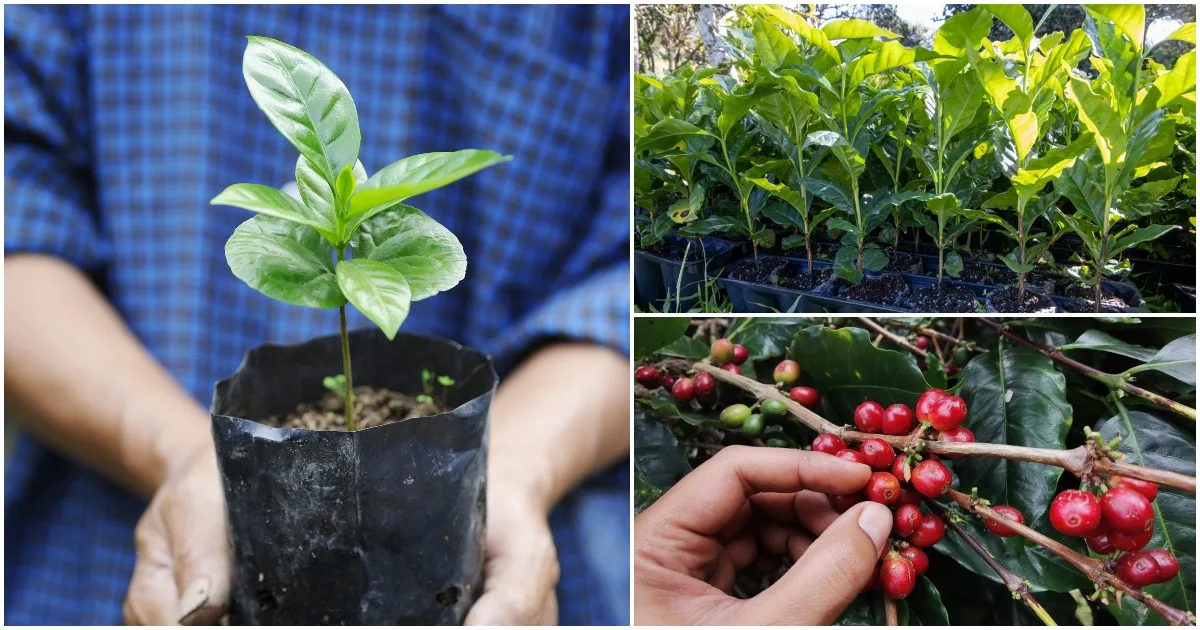
People drink over two billion cups of coffee every day. Most of the commercially grown coffee is found in the tropical and sub-tropical regions of the world.
This big business may seem daunting, but it’s really quite easy to grow your own coffee at home. Its also become a trend to grow a coffee tree indoors as a houseplant. If that sounds more up your street, then we’ve got you covered with our indoor coffee plant care guide here.
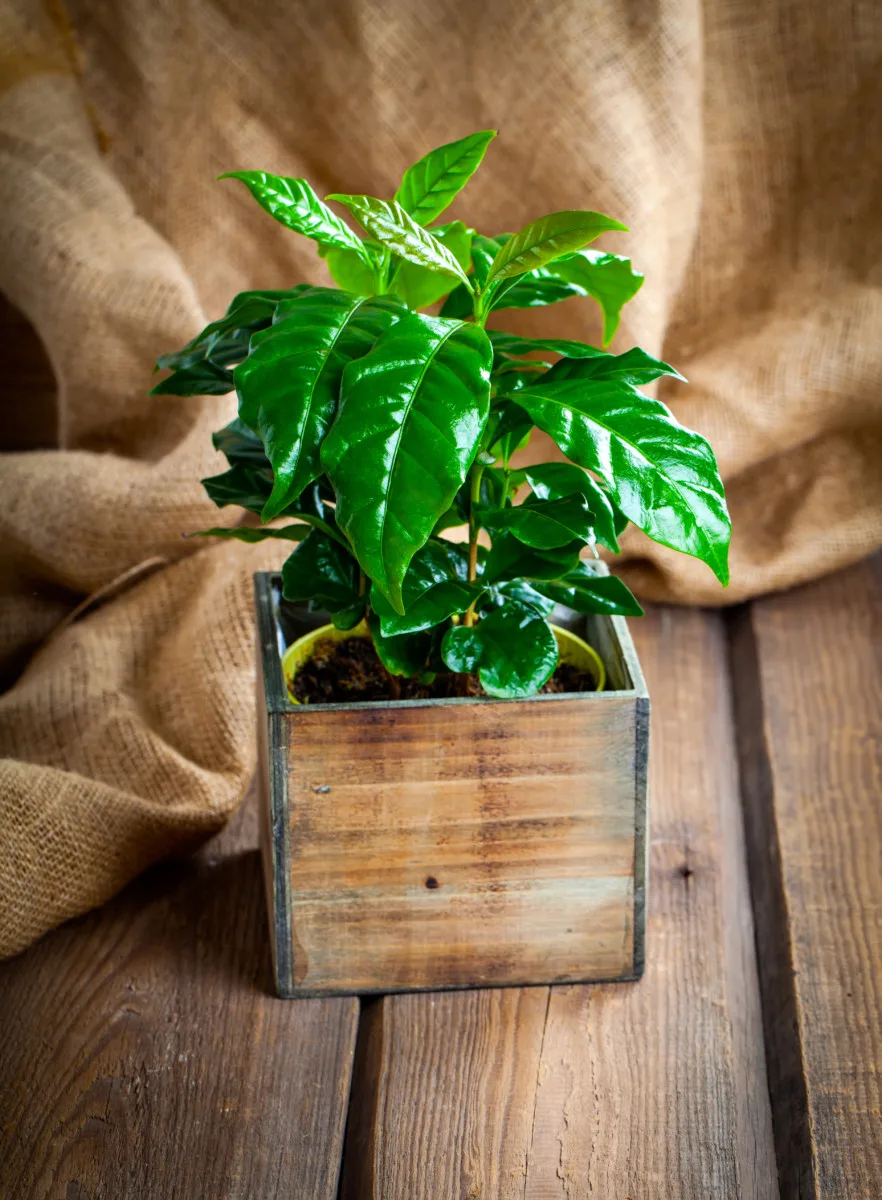
Let’s discover how we can grow our own coffee outdoors.
Coffee Plant Overview
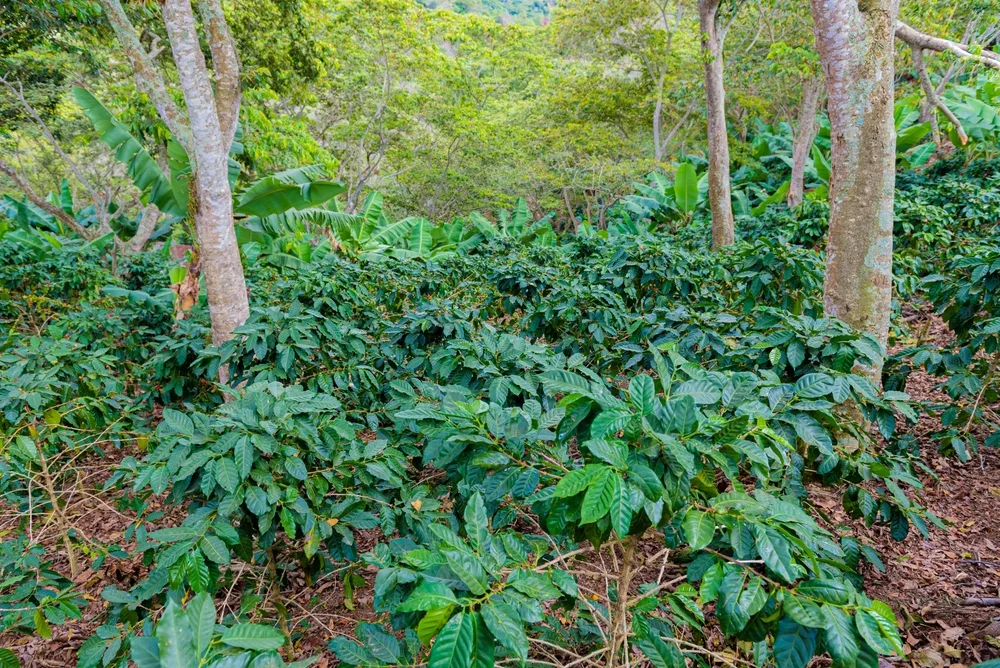
Almost 60-80% of the world’s coffee comes from the coffee plant Coffea arabica, native to Northern Africa. This variety is grown all over the world in tropical and sub-tropical regions. You will find arabica in Africa, the Central and South Americas, the Middle East and Southeast Asia.
Coffee is such an important commodity that it has its own named region. The ‘Bean Belt’ forms along the equatorial zones between the Tropic of Cancer and the Tropic of Capricorn. This area has the right climate and elevations (between 2600 – 7200 feet above sea level) which are ideal for coffee production.
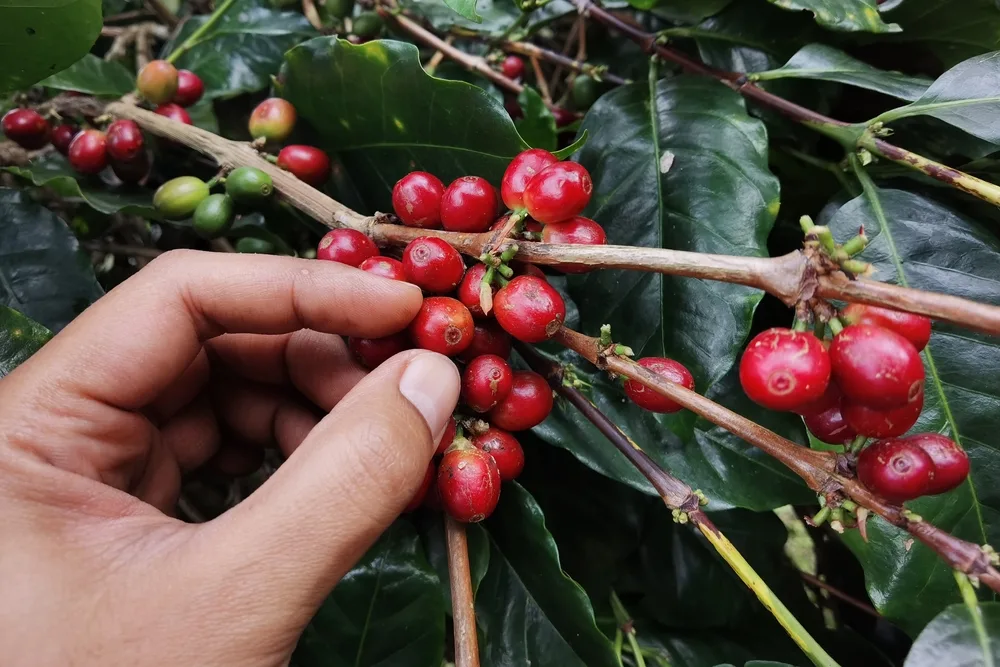
Approximately 20-40% of the world’s coffee comes from another variety, Coffea canephora. Known as ‘Robusta’, this variety has a higher caffeine content than Arabica but is more bitter.
These are the two common commercially grown coffee plants. But that’s not all there is in this genus. The Coffea genus consists of over 120 varieties, with many of them not carrying any caffeine.
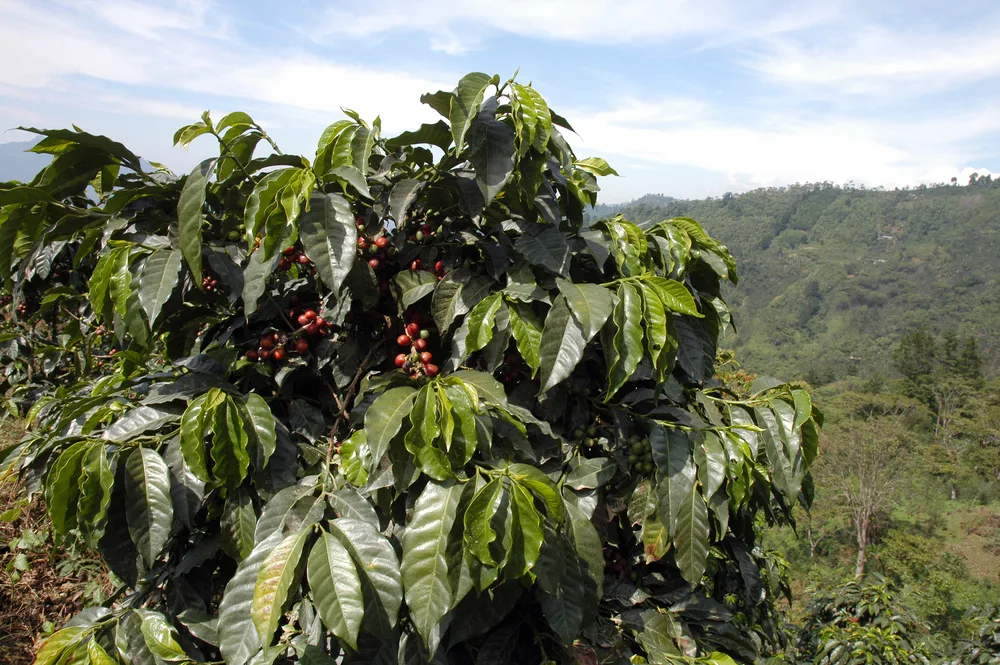
Coffee plants belong to Rubiaceae, named for the position of the leaves on the stems opposite each other and the formation of fused flowers. This family of plants contains more than 13,500 species – the largest diversity in the tropics.
You may recognize similar plants in the ornamental category like Gardenia, Psychotria and Ixora that have similar growth patterns to Coffea.
Growth Habit
Coffee is an evergreen tree with large dark green glossy leaves that form on opposite pairs along the stems.
In 3-4 years from sowing seed, fragrant white flowers appear, making for a spectacular show in spring and summer. Green fruits follow that ripen into red ‘cherries’.
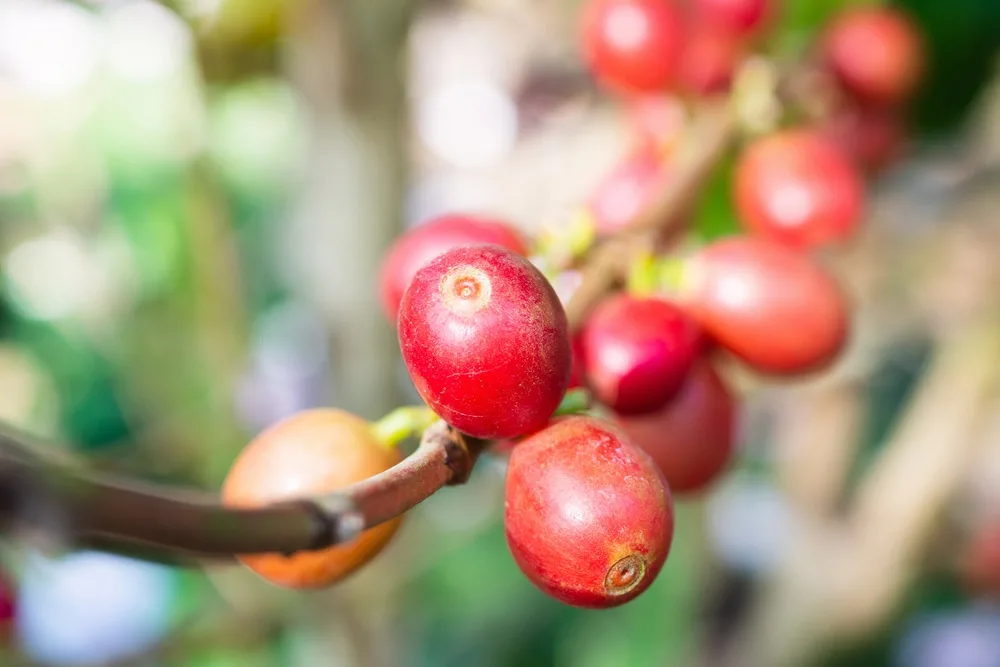
The red cherries are picked, and the skin removed, to reveal a pulp surrounding a husk that contains two beans inside – the important bits.
Once the trees start producing berries, they can live for 60 years or more, so it’s well worth the wait after planting coffee trees before the first harvest.
Varieties
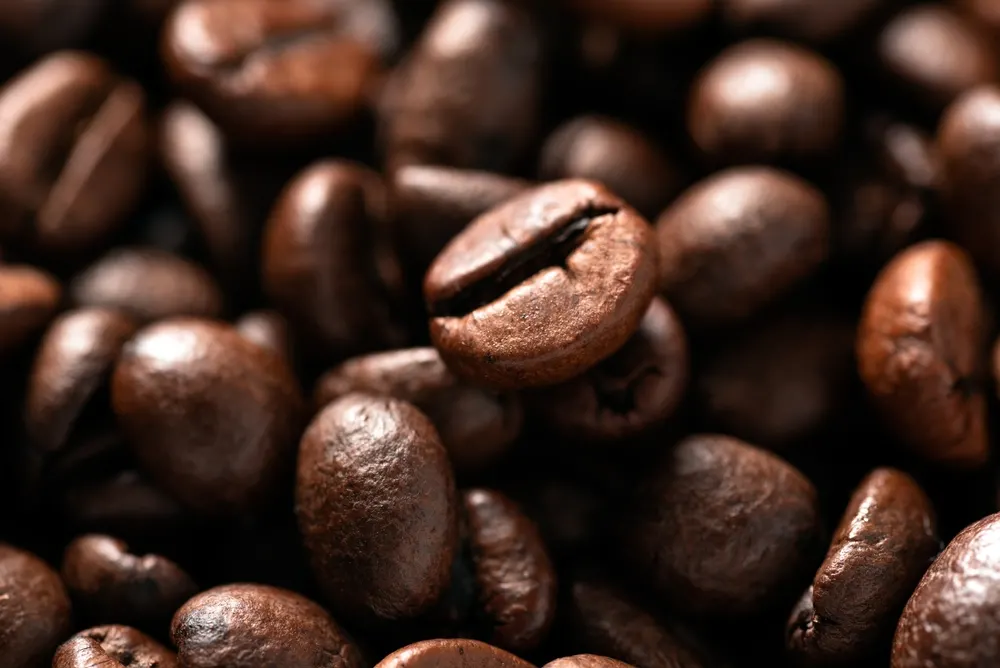
Arabica vs Robusta
Both these species from the same family of plants have different characteristics in their beans.
However, it is important to note that any variety bean planted in a different region with different growing conditions and climate may have a different taste when made into coffee.
This means that coffee grown around the world today and outside the ‘Bean Belt’ can be Arabica or Robusta, but exhibit quite distinctive tones that are localized to the area.
Arabica
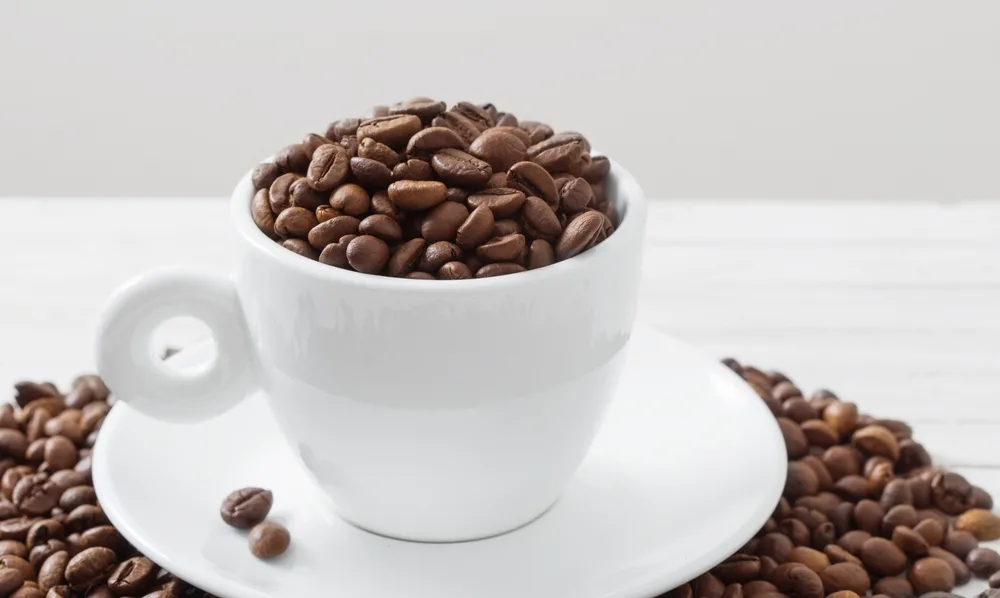
The most popular coffee in the world and deserving of its title due to the smoother slightly sweet taste of the beans with hints of chocolate, fruit and berries. The shrubs or small trees grow up to 15 feet tall but are often pruned to about 6 feet tall to make picking the berries easier.
Arabicas are capable of self-pollination. This makes for a more stable species as cross-pollination doesn’t become an issue.
These plants prefer growing at higher altitudes.
Robusta
Robusta, as the name suggests, is a hardier plant that is more disease resistant and produces better yields. However, because of their bitter flavor and less refined complexities, the beans are considered less desirable.
Espresso blends that require bitterness use robusta beans.

The chlorogenic acids found in these plants give the beans their bitterness. These are naturally occurring antioxidants also found in fruit and vegetables such as apples, carrots and tomatoes.
They also have a high caffeine content, which helps with resistance to pests.
Related reading: 5 Reasons You Should NEVER Use Coffee Grounds In Your Garden
Robusta’s capacity to grow in different altitudes and diverse climates makes it a popular choice for farmers.
It is easier to grow and can reap higher profits due to its higher yields and ease of harvesting. By blending Arabica and Robusta in a 3-1 ratio, costs are lower and profits higher.
These plants are not self-pollinating and need the help of pollinators like bees. They are also taller than Arabica, growing up to 32 feet tall.
Other Varieties
There are two other varieties of coffee worth a mention:
Liberica
This variety (Coffea liberica) was born out of necessity after Arabica and Robusta plants in the 19th Century were almost wiped out by coffee rust.
Liberica lasted longer but did also succumb to the disease eventually. When the coffee industry was resurrected, this type of coffee was grown in the Philippines, Indonesia and Malaysia amongst others.
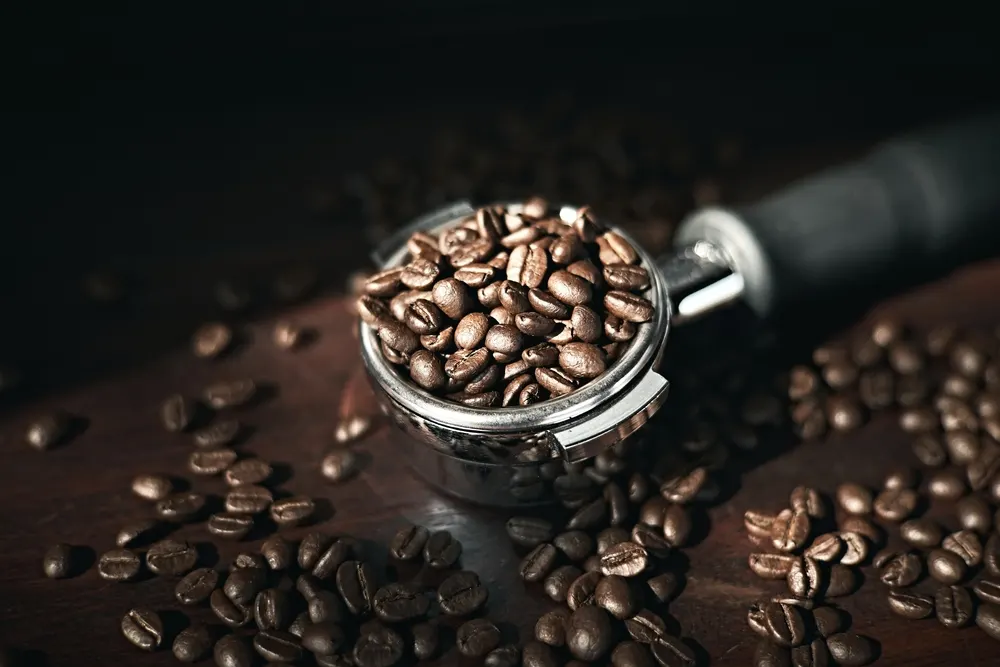
The production of these beans is just 2% of the production worldwide. But, because it is rare, it is sold as a high-end product, and priced higher than other beans.
The beans are much larger than Arabica or Robusta and have the lowest caffeine content of the three types. The taste of the coffee is particularly woody with an aroma of fruit and flowers.
The trees are tall, reaching 66 feet and requiring ladders for harvesting. The cherries, beans and leaves are also larger than other varieties.
Excelsa
Coffea liberica var. dewevrei, also known as Excelsa, is a variety of Liberica with its own distinct bean flavor sought after by coffee enthusiasts.
This type of bean is often used in blended coffees for its depth and complex flavors. It grows mainly in Southeast Asia as a large tree with beans that are characterized by their teardrop shape.
Caffeine
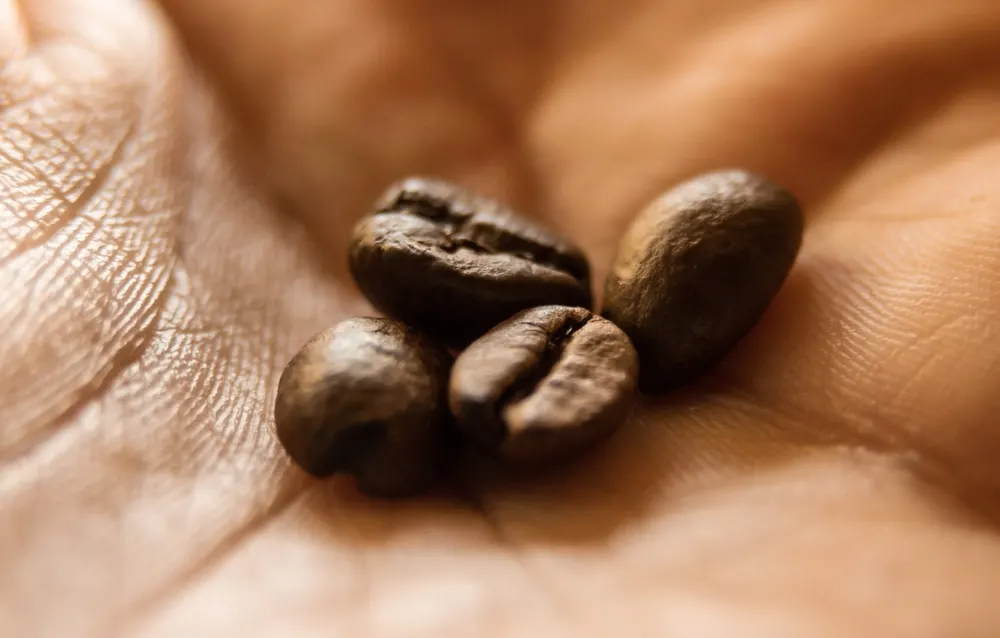
Caffeine is a mild central nervous stimulant that in most cases will cause a person to be more alert. It is a naturally occurring compound in coffee and also in smaller doses in tea and cocoa.
While the amount of caffeine in a particular cup of coffee is often related to the variety, the type of roast, the amount of ground coffee, the brewing method used (plus the serving size) will have an influence on the amount of caffeine too.
A typical serving will have around 75-100mg of caffeine.
Growing Coffee Outdoors
Planting
It’s possible to grow coffee from seed, but you must use green coffee beans – roasted coffee beans will not germinate.
The process takes a long time, especially to get to the harvest stage. With this in mind, it’s best to grow coffee from potted coffee plants you can buy in a nursery.
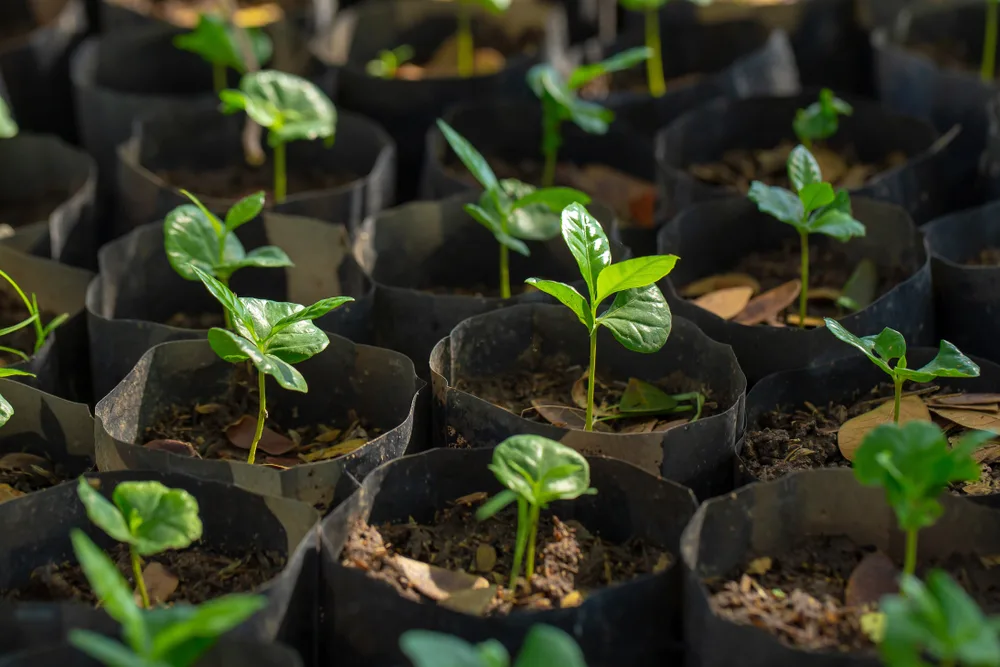
Climate, Temperature & Humidity
The best zones for growing coffee outdoors are USDA Zone 10 or above. If you have a temperate climate with few temperature dips, Zones 7-9 will work as well.
In these zones, they will need to be kept warm in the colder months. Bring them into a greenhouse if possible or cover them with frost protection fabric to keep them warm.
Make sure any movement, whether from a greenhouse or under a frost blanket, is done gradually. The leaves are sensitive and the edges could burn if they get too much sunlight too quickly.
Ideally, the temperature should be between 60°F and 75°F. This temperature range gives the best flavor and complex tones. In saying this, you can grow coffee if the temperatures drop to 41°F on a regular basis, but the results will not be as satisfactory.
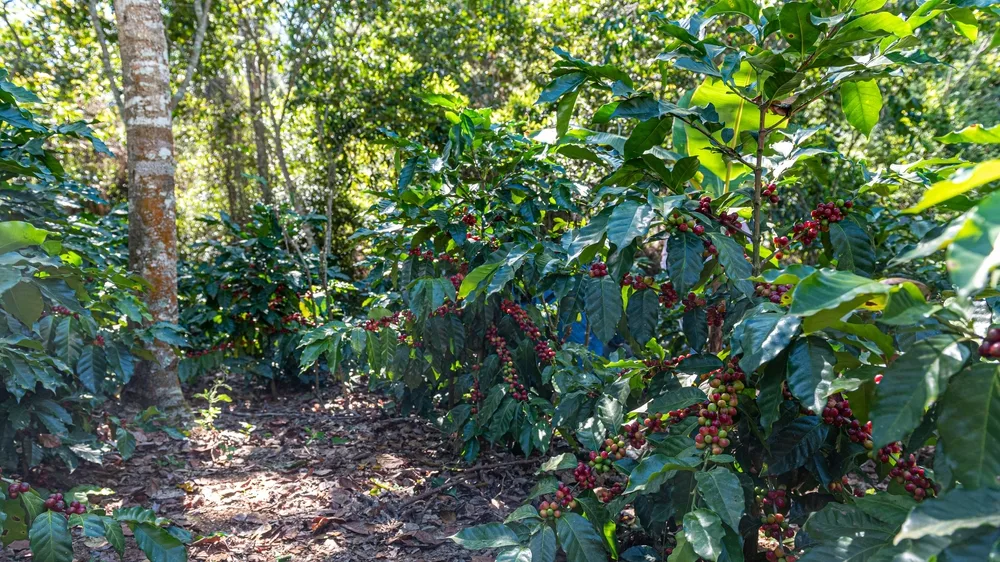
When it comes to humidity, these plants thrive in high humidity with plenty of rain and mist. Look out for browning leaf edges if it’s too dry and add some misters to increase the humidity around the plants.
Light
Coffee plants need warm morning sun, but they cannot handle hot afternoon sun. Full sun is not recommended as the leaves are sensitive, so partial sun is best.
Water
Coffee plants love water and require regular watering in spring, summer and autumn.
They need this water to flower and set fruit – lack of water will prevent them from blooming. But, it is important to avoid overwatering. They need to be kept moist but not waterlogged.
During winter, reduce watering and allow the soil to dry out a bit before watering again.
Soil
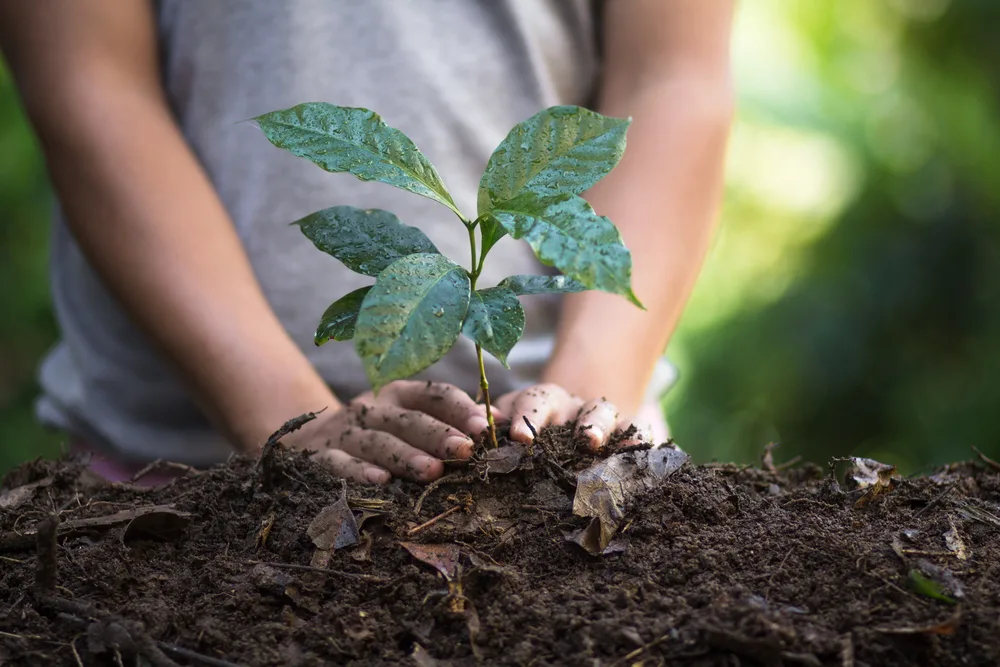
The soil for coffee plants needs to be rich loam, high in nutrients and minerals. The pH should be on the acidic side between 6.0 – 6.5.
Add plenty of compost and organic fertilizer mixed into the soil when planting. After planting, add a layer of mulch to retain moisture in the soil.
Drainage is very important. The soil must drain freely to keep the soil moist but not waterlogged.
Fertilizer
Fertilize in summer regularly during the growing cycle. They like a regular dose of the macronutrients – nitrogen, phosphorous and potassium (NPK) – as well as minerals such as zinc, iron, magnesium and boron.
Look for a balanced slow-release fertilizer that includes all the trace minerals mentioned. Apply according to packaging instructions to avoid overfertilizing.
If the leaves start to yellow, you may have a case of chlorosis. This is a nutrient deficiency that can be treated with foliar sprays and soil feed to fix the problem.
Pruning
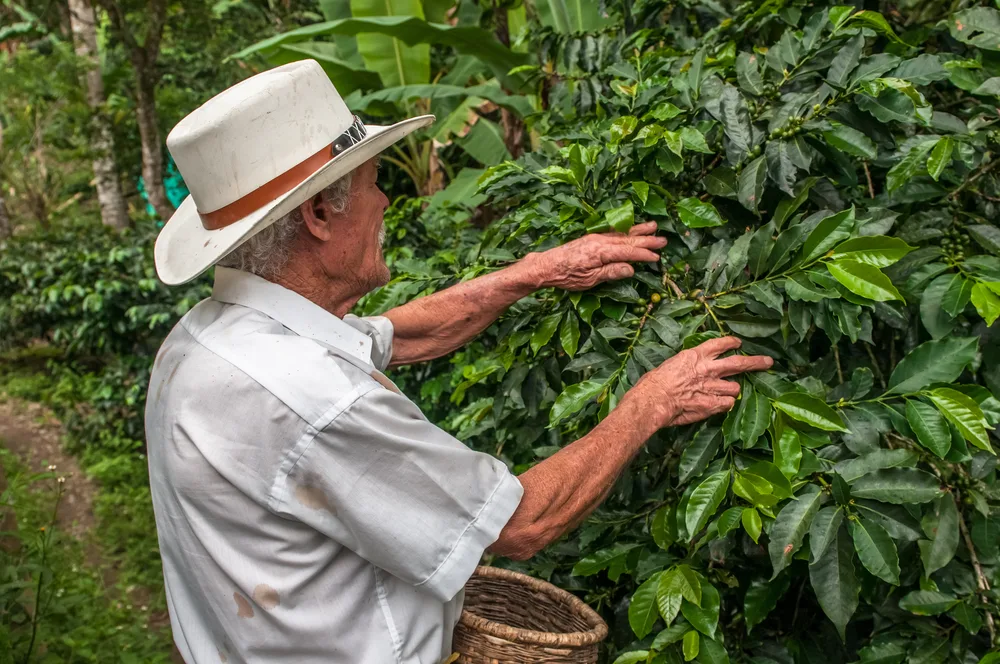
There are two reasons why it’s vital to prune coffee trees.
Firstly, some varieties grow very tall. By pruning them, you keep them more compact, and it becomes easier to harvest the cherries.
Secondly, as the plants age, their vigor and ability to produce big harvests of coffee are reduced. By pruning them, you can keep them in optimal health, producing the best harvests possible.
Pruning also stimulates new growth. This is important for varieties where the cherries form only new wood.
It is important to reduce the bushy growth of coffee so that light and air reach all parts of the tree. A tree with too many leaves too close together will not produce many flowers and fruits and can also attract pests and diseases.
Prune using angled cuts to first remove any unproductive, damaged or unhealthy-looking branches and any suckers.
Then, remove any branches that are too close to each other, giving the healthiest branches the best chance of being productive. In the end, the branches should be even and evenly spaced.
Prune coffee annually after you have harvested the cherries.
Harvesting
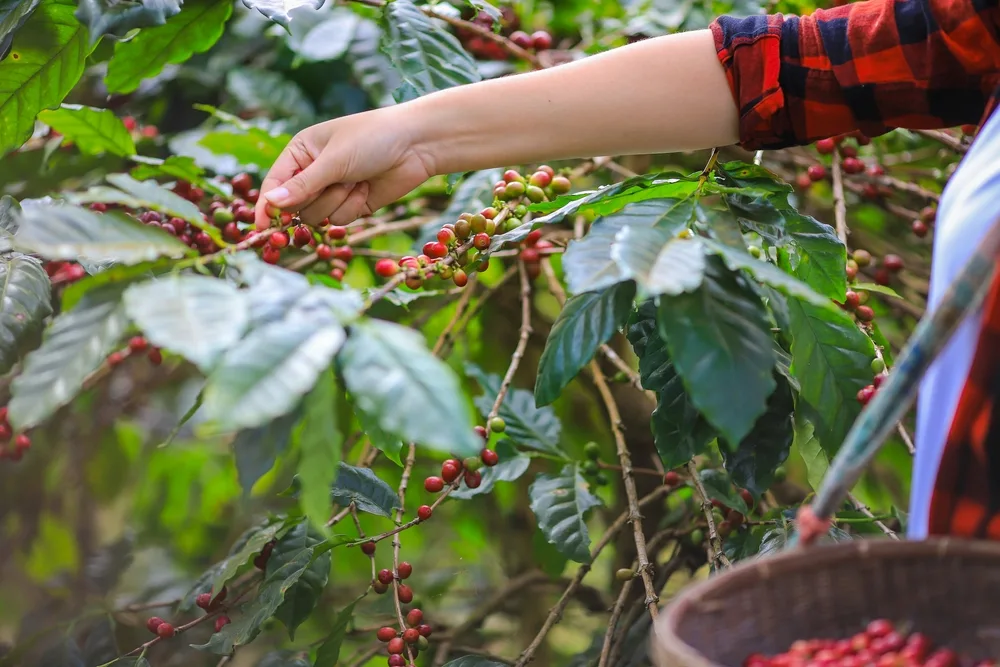
Harvesting takes place in fall or winter once the green berries have turned red. Leave any green berries on the tree to ripen.
Once the cherries have been collected, follow these steps to prepare your roast:
Remove the skin and pulp
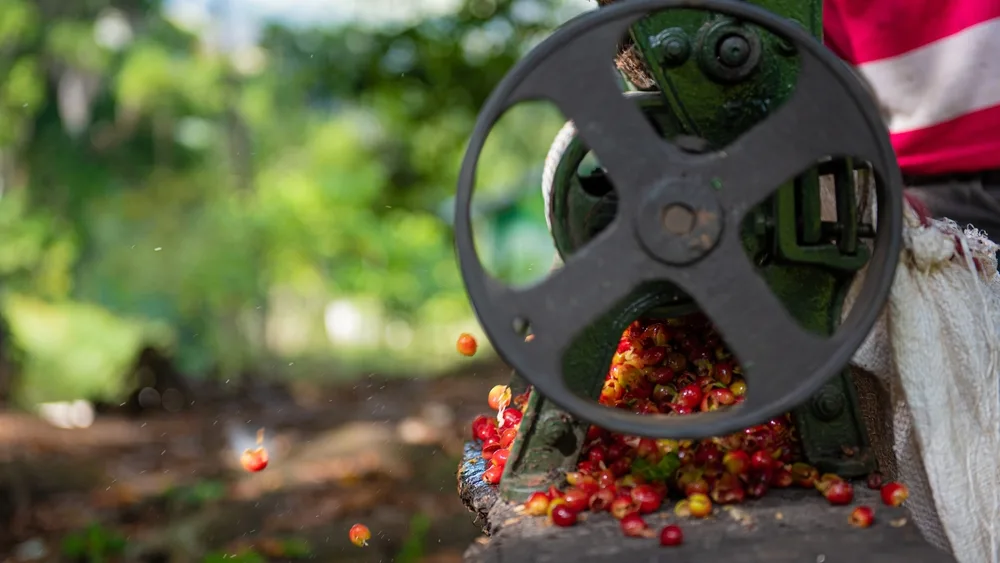
Within 24 hours of harvesting, the skins and pulp need to be removed so that you can get to the beans inside. To do this, squeeze the berries by hand until they pop out of their shells.
Fermentation
The next layer is the mucilage around the beans. This is easily removed by fermenting the beans.
Cover the beans with water in a bucket and leave to ferment. After 18 hours, if they are still slippery, leave for a bit longer.
Once they are gritty and feel clean, you can rinse them several times until the water runs clear.
Drying
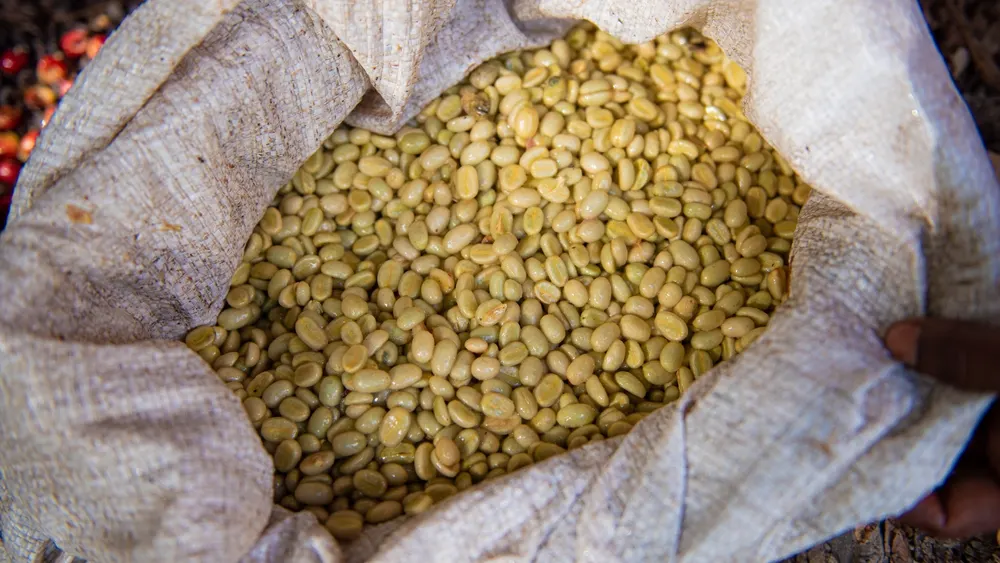
The drying process can take anywhere from 5 to 30 days, depending on the weather. It is usually quicker to use a commercial dehydrator.
For drying in the sun, lay the beans in a single layer on trays and place them in a full sun spot. Move undercover if there is any rain coming. Move the beans around three times a day for even drying.
When they are dried enough, test the beans. They should be hard and solid. If they are still a bit soft and chewy, leave them for longer.
Alternatively, dry the beans in a dehydrator set at 100°F for a few hours until you get the desired results.
Hulling
To get to the useable beans, you need to get rid of the hard husk or parchment on the outside. Cracking is the best way to do this. Place the beans between kitchen paper or a clean dishcloth and crush with a rolling pin.
You can also place them in a food processor if you have plastic blades to avoid damaging the beans and pulse them until the husks come clear.
If you still have a thin silver skin, rub the beans together to remove them. Discard the parchments. A hairdryer can be handy to blow away the lighter parchments from the beans.
Roasting At Home
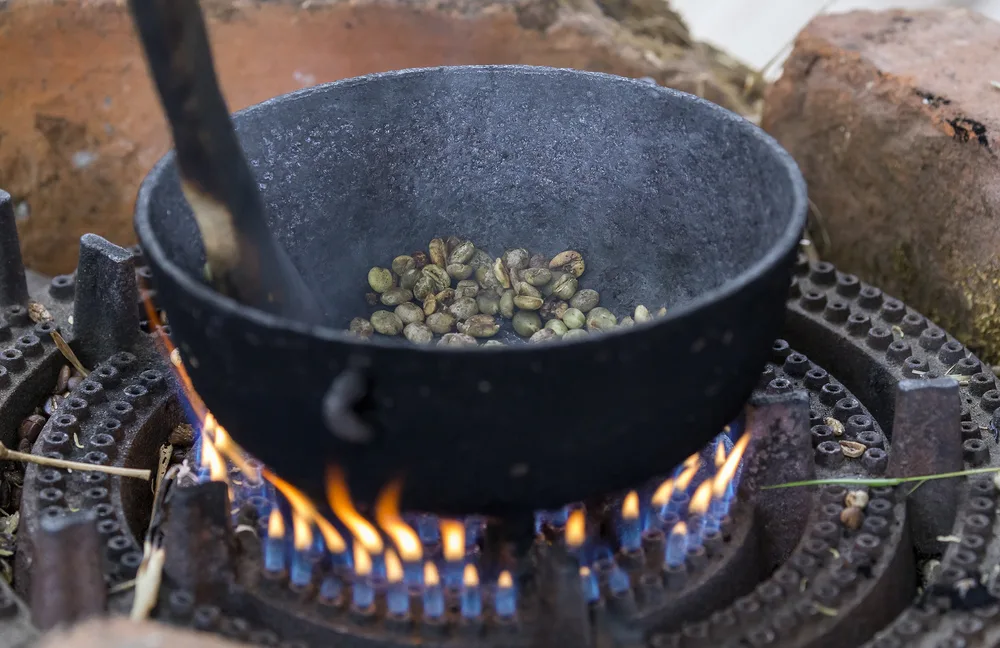
Once the beans have been prepared and unveiled, it’s time for roasting.
Green Coffee
At this stage, the beans are green and can be used to make green coffee.
Since the 2000s, green coffee made from unroasted green coffee beans has been on the market as a weight loss tip and nutritional supplement.
The chlorogenic acids in green beans are much more pronounced than in roasted beans and it’s for this reason that green beans became popular. It is believed that the strong antioxidant properties of these acids are the reason green beans have health benefits.
Most of the flavor in coffee comes from the roasting process. So, if you drink green coffee, you may not even notice its coffee at all.
Soak the beans overnight in water. Bring the mixture of beans and water to a boil and simmer for 15 minutes. Strain and remove the beans before drinking and keep any leftover coffee in the refrigerator. Use within a few days.
Alternatively, grind the beans to a medium-fine grain and add to a cup with hot but not boiling water. Steep for 10 minutes and strain to drink.
Roasting
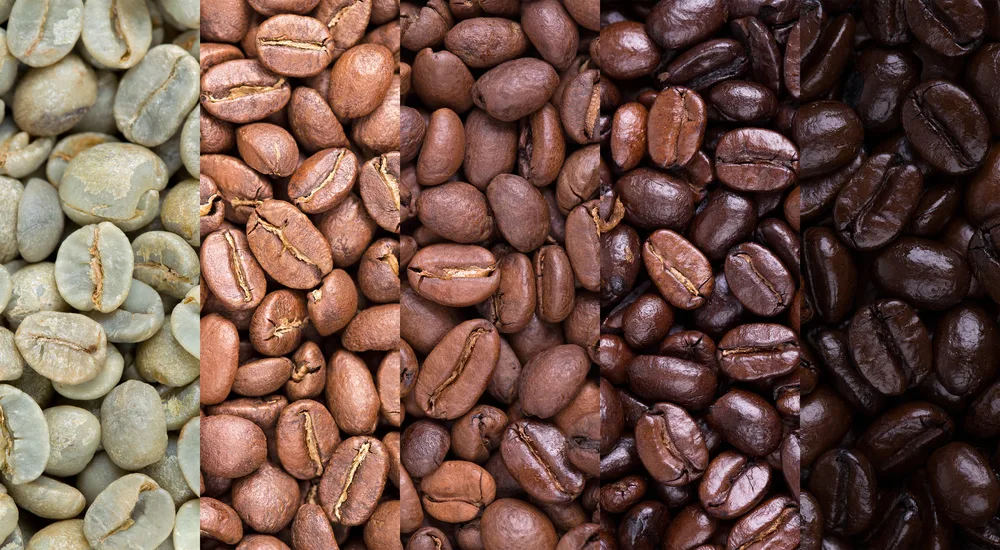
Roasting at home may sound complex, but all you need is a hot oven at around 450F and 12 minutes of your time. Place the beans evenly on a baking tray and stir the beans every couple of minutes to evenly roast.
Alternatively add the beans to a saucepan or frying pan and roast in a dry pan over high heat, stirring continuously until you have the desired color and depth of roast.
Tracey has a whole article that will walk you through roasting coffee at home, step-by-step.
Easily Roast Coffee Beans At Home For Fresher, Richer Coffee
The goal of roasting is to get a balance of sweetness, bitterness and acidity.
For a more sophisticated result, track the roasting process by color:

- Green – usually contains 7-11% water and need to be dried off before the browning takes place. It usually takes about 3 minutes for the excess moisture to evaporate, allowing for better roasting further down the line.
- Yellow – As the beans start to roast, they turn yellow but are not yet ready to produce a good coffee and have an unpleasant taste.
- Light Brown – Water vapor and gas build up in the beans occurs and once the pressure peaks, the bean cracks open with a popping sound and doubles in volume. This is the first crack stage.
- Dark brown – As browning continues, a second crack occurs and oils are pushed to the surface of the bean which changes its profile considerably.
- Dark – the final stage of roasting is the dark almost black stage, where the flavors are bitter but full bodied.
After the coffee has reached the desired roast, the beans need to be cooled rapidly to stop the roasting process and retain flavor. This can be done by placing single layers on trays or by spraying with a water mist.
Related Reading: 28 Uses For Spent Coffee Grounds You’ll Actually Want To Try
If you grow your own coffee, this may be an opportunity to invest in a home roasting machine to refine your roasts.
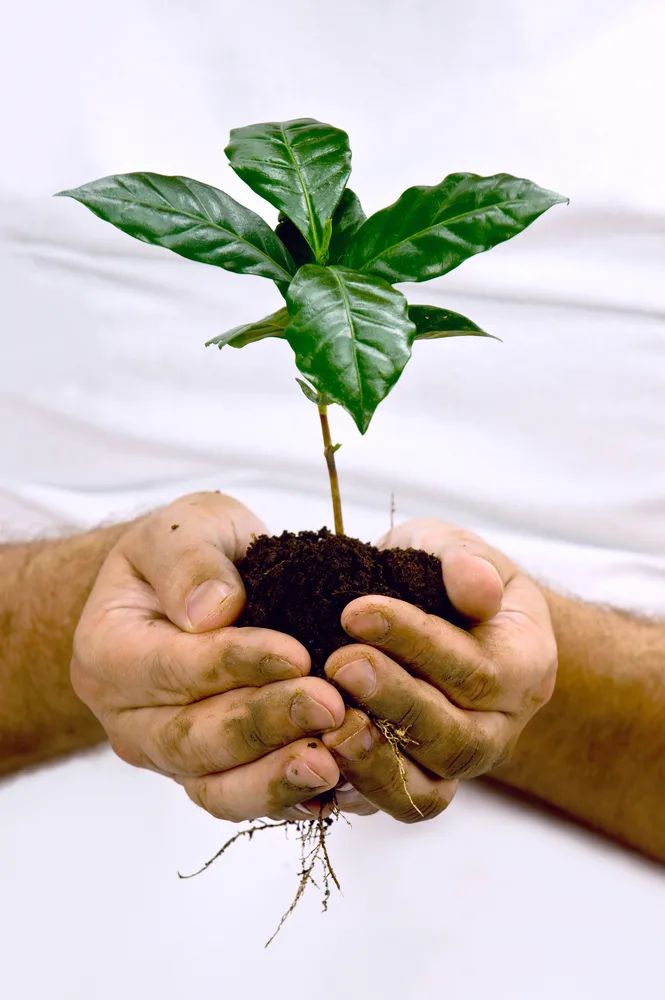
If you live in the right zone to grow coffee plants outdoors, it’s certainly worth the effort. The trees are very ornamental and when in flower, they are a stunning feature.
Besides the joy of growing the plants, harvesting the beans and producing a fine cup of coffee from scratch cannot be matched.
If all of this seems a bit much, why not grow your own beautiful indoor coffee plant. You won’t be drinking your own freshly grown coffee any time soon, but it still looks great!
Read Next: How to Grow a Beautiful Coffee Plant Indoors

Get the famous Rural Sprout newsletter delivered to your inbox.
Including Sunday musings from our editor, Tracey, as well as “What’s Up Wednesday” our roundup of what’s in season and new article updates and alerts.

